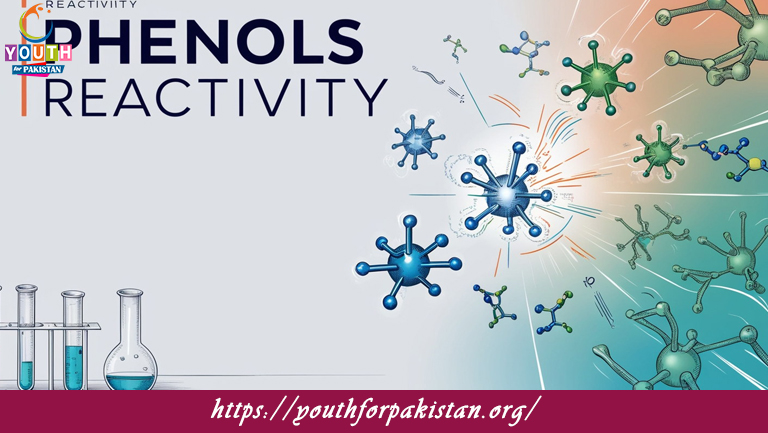Welcome to the Phenols Reactivity MDCAT MCQs with Answers. In this post, we have shared Phenols Reactivity Multiple Choice Questions and Answers for PMC MDCAT 2024. Each question in MDCAT Chemistry offers a chance to enhance your knowledge regarding Phenols Reactivity MCQs in this MDCAT Online Test.
Phenol reacts with bromine to form:
a) Phenol bromide
b) 2,4,6-Tribromophenol
c) 2-Bromophenol
d) Bromobenzene
The reagent used to distinguish phenol from alcohol is:
a) Bromine water
b) Sodium hydroxide
c) Hydrochloric acid
d) Sodium metal
Phenol reacts with iron(III) chloride to form:
a) Green solution
b) Blue solution
c) Red solution
d) Yellow solution
Phenol reacts with zinc to produce:
a) Phenyl zinc chloride
b) Benzene
c) Phenyl hydrazine
d) Sodium phenoxide
The reaction of phenol with formaldehyde in the presence of an acid catalyst forms:
a) Phenolic resin
b) Phenol formaldehyde
c) Benzaldehyde
d) Toluene
Phenol reacts with nitric acid to give:
a) Nitrobenzene
b) 2-Nitrophenol and 4-Nitrophenol
c) Nitropropane
d) Benzene
Which of the following is a product of phenol and chloroform reaction in alkaline medium?
a) Benzene
b) Phenyl chloroformate
c) Salicylaldehyde
d) Phenol-formaldehyde resin
When phenol reacts with sodium hydroxide, it forms:
a) Sodium phenoxide
b) Sodium benzoate
c) Sodium chloride
d) Sodium phenylate
Phenol can be oxidized to:
a) Benzoic acid
b) Benzaldehyde
c) Toluene
d) Benzene
Phenol reacts with acetic anhydride to form:
a) Phenyl acetate
b) Phenyl acetic acid
c) Benzyl acetate
d) Acetophenone
The reaction of phenol with sulfuric acid forms:
a) Phenyl sulfate
b) Phenol sulfate
c) Sulfophenol
d) Sulfuric acid
Which reagent is used to identify phenol by forming a colored complex?
a) Iron(III) chloride
b) Bromine water
c) Sodium hydroxide
d) Hydrochloric acid
Phenol reacts with zinc chloride to give:
a) Phenyl zinc chloride
b) Benzene
c) Phenol zinc chloride
d) Phenyl hydrazine
Phenol in the presence of alkaline KMnO₄ gives:
a) Benzoic acid
b) Benzaldehyde
c) Benzene
d) Phenyl alcohol
The reaction of phenol with ethyl bromide in the presence of sodium ethoxide produces:
a) Ethyl phenyl ether
b) Ethyl benzoate
c) Phenyl ethyl ether
d) Benzyl ethyl ether
Which product is obtained when phenol is reacted with chlorosulfonic acid?
a) Phenylsulfonic acid
b) Sulfonyl chloride
c) Benzene sulfonic acid
d) Chlorobenzene
Phenol reacts with bromine in carbon tetrachloride to form:
a) 2,4-Dibromophenol
b) 2-Bromophenol
c) 4-Bromophenol
d) 3-Bromophenol
When phenol reacts with methyl iodide in the presence of a base, the product formed is:
a) Methyl phenyl ether
b) Phenyl methyl ether
c) Methoxybenzene
d) Phenyl iodide
The reaction of phenol with zinc gives:
a) Phenyl zinc chloride
b) Benzene
c) Phenol zinc oxide
d) Phenyl hydrazine
The primary product of phenol and acetyl chloride reaction is:
a) Phenyl acetate
b) Phenol acetate
c) Benzyl acetate
d) Acetophenone
The reaction of phenol with concentrated sulfuric acid forms:
a) Phenyl sulfate
b) Sulfophenol
c) Phenol sulfate
d) Sulfonic acid
Phenol when treated with acetic anhydride forms:
a) Phenyl acetate
b) Benzyl acetate
c) Acetophenone
d) Phenyl acetic acid
The reaction of phenol with formaldehyde in the presence of an acid catalyst yields:
a) Phenolic resin
b) Benzyl alcohol
c) Phenyl formaldehyde
d) Toluene
Phenol reacts with nitric acid to give:
a) Nitrobenzene
b) 2-Nitrophenol and 4-Nitrophenol
c) Benzyl nitrite
d) Nitrobenzene
Phenol in the presence of sulfuric acid gives:
a) Phenyl sulfate
b) Phenol sulfate
c) Sulfophenol
d) Sulfuric acid
Phenol reacts with bromine water to produce:
a) 2,4,6-Tribromophenol
b) 2-Bromophenol
c) 4-Bromophenol
d) 3-Bromophenol
The reaction of phenol with methyl iodide in the presence of a base forms:
a) Methyl phenyl ether
b) Phenyl methyl ether
c) Methoxybenzene
d) Phenyl iodide
The IUPAC name for phenol is:
a) Hydroxybenzene
b) Benzene hydroxide
c) Phenyl alcohol
d) Phenoxybenzene
The reaction of phenol with phosphorus trichloride gives:
a) Phenyl chloride
b) Phenol chloride
c) Phosphoric acid
d) Phenyl phosphate
Phenol reacts with sulfur dioxide to form:
a) Phenyl sulfonic acid
b) Sulfophenol
c) Sulfonic acid
d) Phenyl sulfate
Phenol in the presence of concentrated sulfuric acid yields:
a) Phenyl sulfate
b) Phenol sulfate
c) Sulfophenol
d) Sulfuric acid
The product obtained from phenol and acetic anhydride reaction is:
a) Phenyl acetate
b) Phenol acetate
c) Benzyl acetate
d) Acetophenone
Phenol reacts with zinc oxide to give:
a) Phenyl zinc oxide
b) Phenol
c) Benzene
d) Phenyl hydrazine
When phenol reacts with bromine in aqueous solution, the product formed is:
a) 2,4,6-Tribromophenol
b) 2-Bromophenol
c) 4-Bromophenol
d) 3-Bromophenol
The reaction of phenol with concentrated hydrochloric acid results in:
a) Phenol hydrochloride
b) Benzene
c) Phenyl chloride
d) Hydrochloric acid
Phenol when treated with acetyl chloride yields:
a) Phenyl acetate
b) Benzyl acetate
c) Acetophenone
d) Phenyl acetic acid
Phenol in the presence of potassium hydroxide reacts to form:
a) Sodium phenoxide
b) Potassium phenoxide
c) Sodium benzoate
d) Potassium benzoate
Phenol reacts with phosphorus pentachloride to form:
a) Phenyl chloride
b) Phenol chloride
c) Phosphoric acid
d) Phenyl phosphate
The primary product of phenol and methyl iodide reaction in the presence of base is:
a) Methoxybenzene
b) Methyl phenyl ether
c) Phenyl methyl ether
d) Phenyl iodide
The reaction of phenol with sulfur dioxide forms:
a) Phenyl sulfonic acid
b) Phenol sulfonic acid
c) Benzene sulfonic acid
d) Phenyl sulfate
If you are interested to enhance your knowledge regarding Physics, Chemistry, Computer, and Biology please click on the link of each category, you will be redirected to dedicated website for each category.








